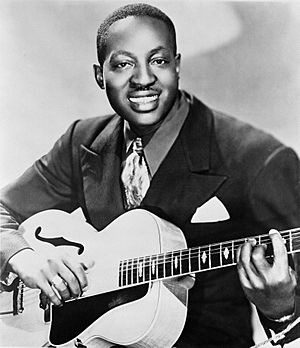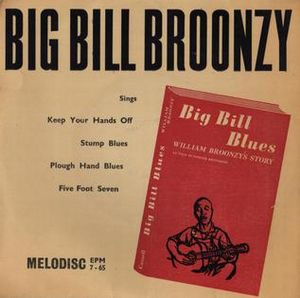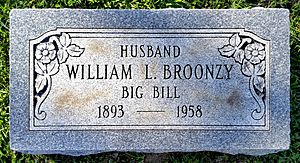Big Bill Broonzy facts for kids
Quick facts for kids
Big Bill Broonzy
|
|
|---|---|

Broonzy in 1951
|
|
| Background information | |
| Birth name | Lee Conley Bradley |
| Also known as | Willie Broonzy, Big Bill Broonzy, Big Bill Broomsley |
| Born | June 26, 1903 (year disputed) Lake Dick, Arkansas or Scott, Mississippi, U.S. |
| Died | August 14, 1958 (aged 55) Chicago |
| Genres | Blues |
| Occupation(s) | Musician, songwriter |
| Instruments | Vocals, guitar |
| Years active | 1927–1958 |
| Labels | |
Big Bill Broonzy (born Lee Conley Bradley; June 26, 1903 – August 14, 1958) was an American blues singer, songwriter, and guitarist. He started his music career in the 1920s, playing country music for mostly African American audiences. In the 1930s and 1940s, his style changed to a more urban blues sound. This sound was popular with working-class black audiences.
In the 1950s, he went back to his traditional folk-blues style. This made him one of the main figures in the new American folk music revival. He became a star around the world. His long and varied career shows he was a very important person in how blues music grew in the 20th century. Broonzy wrote over 300 songs. These included his own blues songs and new versions of old folk songs. He was special because his songs often shared his experiences of moving from country life to city life.
Contents
Life and career
Early years
Big Bill Broonzy was born Lee Conley Bradley. He was one of 17 children. The exact date and place of his birth are not fully known. Broonzy said he was born in Scott, Mississippi. But some research suggests he was born in Jefferson County, Arkansas. He also said he was born in 1893, but family records found later suggest it was 1903.
Soon after he was born, his family moved to Lake Dick, Arkansas. This is where Bill grew up. He started playing music when he was young. At age 10, he made a fiddle from a cigar box. He learned to play spirituals and folk songs from his uncle, Jerry Belcher. He and his friend, Louis Carter, who played a homemade guitar, performed at parties and church events.
Some stories say that in 1917, Broonzy was drafted into the Army for World War I. However, a biographer named Bob Riesman found that Broonzy was only 14 in 1917. This means he was too young to serve in the Army during World War I. In 1920, Broonzy moved north to Chicago to find new chances.
1920s: Starting in Chicago
When Broonzy arrived in Chicago, he switched from playing the fiddle to the guitar. He learned guitar from Papa Charlie Jackson, a famous performer. During the 1920s, Broonzy worked many different jobs to earn money. But music was his main passion. He played often at parties and social events, getting better at guitar. He wrote one of his well-known guitar songs, "Saturday Night Rub," during this time.
Broonzy got a chance to audition for Paramount Records. His first recordings were not very good. But he kept trying, and his second try was better. His first record, "Big Bill's Blues," came out in 1927. It was not a big hit, but Paramount Records kept him. In the next few years, he released more songs.
1930s: Growing fame
In 1930, Paramount Records used Broonzy's full name on a record for the first time. His record sales were still low, so he worked at a grocery store. Then, he met Lester Melrose, who helped musicians record for different labels. Broonzy started recording more songs. In 1932, he began recording for American Record Corporation. These records sold better, and Broonzy became more known. He played regularly in clubs in Chicago and toured with Memphis Minnie.
In 1934, Broonzy started recording for Bluebird Records. His music began to sound more like R&B. His singing also became stronger and more personal. In 1937, he started playing with a small band. Broonzy's reputation grew. In 1938, he was asked to play at the "From Spirituals to Swing" concert at Carnegie Hall. This was a very important concert. He also appeared in the 1939 concert there.
His success led him to a small role in a show called Swingin' the Dream. This show was a jazz version of Shakespeare's Midsummer Night's Dream. Famous musicians like Louis Armstrong were also in the show. Broonzy also wrote many popular songs for his half-brother, Washboard Sam, and his friends Jazz Gillum and Tampa Red. He often played guitar on their songs without being credited.
1940s: Expanding his music
Broonzy wrote more songs in the 1940s. He was good at writing songs that appealed to both city people and those from the countryside. During this time, he played many different types of music. These included ragtime, hokum blues, country blues, urban blues, jazz-like songs, folk songs, and spirituals.
After World War II, Broonzy recorded songs that helped other musicians move towards the electric blues sound of Chicago. His songs "Where the Blues Began" and "Martha Blues" showed this new direction. One of his most famous songs, "Key to the Highway," also came out around this time. In 1948, he signed with Mercury Records.
In 1949, Broonzy joined a touring folk music show called I Come for to Sing. This show helped him become known in the growing American folk music revival. He even worked as a janitor at Iowa State University for a while when he needed a break from touring.
1950s: International star
After returning to performing, Broonzy toured Europe in 1951. People loved his music there, giving him standing ovations. This tour changed his career. When he came back to the United States, he performed with famous folk artists like Pete Seeger. From 1953 on, he earned enough money from music to live comfortably. He went back to his solo folk-blues style and traveled and recorded a lot.
Broonzy's many performances in British clubs in the 1950s greatly influenced British audiences' understanding of the blues. He helped the early blues scene in Britain grow. Many British musicians, like Bert Jansch, said he was a big influence. Even John Lennon and Paul McCartney of the Beatles said Broonzy was an important early influence.
In 1953, Broonzy worked as a summer camp cook at Circle Pines Center in Michigan. In 1954, Pete Seeger visited and performed a concert with Broonzy, which was recorded for a radio station. In 1955, Broonzy published his autobiography, Big Bill Blues. He toured all over the world, including Africa, South America, and Europe. In 1957, he helped start the Old Town School of Folk Music.
Illness and death
In the late 1940s, Broonzy's doctor warned him that his constant traveling and musician lifestyle would affect his health. In June 1956, Broonzy started feeling unwell. From 1956 to 1957, during his last tour in Europe, his condition got worse. In July 1957, he was diagnosed with cancer.
Broonzy made his last recordings in Chicago in July 1957. In September 1957, he had surgery to remove one of his lungs. He hoped to return to Europe, but he never toured there again. Another surgery in late 1957 damaged his vocal cords, and he could not perform anymore.
By 1958, Broonzy was suffering from throat cancer. A benefit concert was held to help him with his medical bills. The concert raised about $2,000. Broonzy reportedly stood on stage after the show, thanking everyone for their support.
Big Bill Broonzy died on August 14 or 15, 1958, from cancer. He was buried in Lincoln Cemetery in Blue Island, Illinois.
Style and influence
Broonzy's music was influenced by the folk music, spirituals, work songs, ragtime music, hokum, and country blues he heard growing up. He also learned from other musicians like Jimmie Rodgers and Blind Lemon Jefferson. Broonzy mixed all these styles to create his own blues sound. This sound helped shape the Chicago blues that became popular later with artists like Muddy Waters.
Even though he helped create the Chicago blues style and used electric instruments early on, white audiences in the 1950s wanted to hear him play his older songs with just his acoustic guitar. They felt this was more "authentic."
Broonzy's song "Black, Brown and White" talked about the unfair treatment of black Americans. This song has been used around the world to teach about racism.
Many of Broonzy's early recordings have been re-released. The Smithsonian's Folkways Records has also released several albums of his music. In 1980, he was put into the first class of the Blues Hall of Fame. In 2007, he was inducted into the Gennett Records Walk of Fame.
Broonzy's acoustic guitar playing inspired many musicians, including Muddy Waters, Memphis Slim, Ray Davies, and Steve Howe. Ronnie Wood of the Rolling Stones said Broonzy's "Guitar Shuffle" was one of the first songs he learned to play. Eric Clapton said Broonzy was a big inspiration for how to play acoustic guitar. Clapton even put Broonzy's song "Hey Hey" on his album Unplugged.
Tom Jones also said Broonzy was a major influence. Jerry Garcia, who later started the Grateful Dead, was so influenced by Broonzy's blues playing that he traded his accordion for an electric guitar. The Grateful Dead often played songs that Broonzy had recorded years earlier.
In 2009, at President Barack Obama's inauguration, the civil rights leader Rev. Dr. Joseph Lowery used words from Broonzy's song "Black, Brown and White Blues." An interview with Broonzy from 1955, where he talked about his life and the blues, is available online.
Discography
Between 1927 and 1942, Broonzy recorded 224 songs. This made him one of the most recorded blues artists during that time. His records were released before blues records were tracked by music magazines. By the time Billboard magazine started its "race music" charts in 1942, Broonzy's recordings were less popular.
Selected singles
Many of Broonzy's songs were released by different record companies, sometimes with different names.
| Date | Title | Label & Cat. no. | Comments |
|---|---|---|---|
| 1927 | "Big Bill's Blues" | Paramount 12656+ | as Big Bill and Thomps |
| "House Rent Stomp" | Paramount 12656 | as Big Bill and Thomps | |
| 1930 | "Station Blues" | Paramount 13084 | as Big Bill Broomsley |
| "Saturday Night Rub" | Perfect 147+ | as Famous Hokum Boys | |
| "I Can't Be Satisfied" | Perfect 157 | as Sammy Sampson | |
| 1932 | "Mistreatin' Mama" | Champion 16396+ | as Big Bill Johnson |
| 1934 | "At the Break of Day" | Bluebird 5571+ | |
| "C. C. Rider" | Melotone 13311+ | ||
| 1935 | "Midnight Special" | Vocalion 03004 | as State Street Boys |
| "Bricks in My Pillow" | ARC 6–03–62 | ||
| 1936 | "Matchbox Blues" | ARC 6–05–56+ | |
| 1937 | "Mean Old World" | Melotone 7–07–64+ | |
| 1937 | "Louise Louise Blues" | Vocalion 03075+ | |
| 1938 | "New Shake 'Em on Down" | Vocalion 04149+ | electric guitar by George Barnes |
| "Night Time Is the Right Time No. 2" | Vocalion 04149+ | electric guitar by George Barnes | |
| 1939 | "Just a Dream" | Vocalion 04706+ | |
| "Too Many Drivers" | Vocalion 05096 | ||
| 1940 | "You Better Cut That Out" | Okeh 05919 | |
| "Lonesome Road Blues" | Okeh 06031 | ||
| "Rockin' Chair Blues" | Okeh 06116+ | ||
| 1941 | "All By Myself" | Okeh 06427+ | |
| "Key to the Highway" | Okeh 06242+ | ||
| "Wee Wee Hours" | Okeh 06552 | ||
| "I Feel So Good" | Okeh 06688+ | ||
| 1942 | "I'm Gonna Move to the Outskirts of Town" | Okeh 06651 | as Big Bill & His Chicago 5 |
| 1945 | "Please Believe Me" | Hub 3003-A (HU418B) | as Little Sam, blues vocalist, with Don Byas Quartet |
| 1945 | "Why Did You Do That To Me" | Hub 3003-B (HU 419B) | as Little Sam, blues vocalist, with Don Byas Quartet |
| 1951 | "Hey Hey" | Mercury 8271 |
Broonzy also played guitar on recordings by Lil Green, Sonny Boy Williamson I, Washboard Sam, Jazz Gillum, and other artists.
Albums
- Big Bill Broonzy and Washboard Sam (1953)
- Big Bill Broonzy and Roosevelt Sykes (DVD, recorded 1956)
- His Story (Folkways Records, 1957)
- Big Bill Broonzy Sings Country Blues (Folkways Records FA 2326, 1957)
- Blues with Big Bill Broonzy, Sonny Terry and Brownie McGhee (Folkways Records, 1959)
- Big Bill Broonzy Sings Folk Songs (Folkways Records FA 2328, 1962)
- Big Bill Broonzy Sings Folk Songs (Smithsonian Folkways, 1989) (reissue)
- Best of the Blues Tradition (1991)
- Do That Guitar Rag (1928–1935) (1991)
- Trouble in Mind (Smithsonian Folkways, 2000)
- Broonzy Volume 2: 1945–1949: The Post War Years (2000)
- Big Bill Broonzy in Concert (2002)
- Big Bill Broonzy on Tour in Britain: Live in England & Scotland (2002)
- Big Bill Blues: His 23 Greatest Songs 1927–42 (2004)
- Get Back (2004)
- Big Bill Amsterdam Live Concerts 1953 (2006)
- Keys to the Blues (2009)
- All The Classics 1936-1937, Vol. 4 (2019)
See also
 In Spanish: Big Bill Broonzy para niños
In Spanish: Big Bill Broonzy para niños



